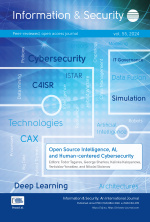Self-regulation as a Risk Mitigation Tool in the Design and Construction of Critical Infrastructures
Source:
Information & Security: An International Journal,Keywords:
construction, Critical Infrastructure, exploitation, risk management, security, self-regulationAbstract:
Critical infrastructures are of strategic significance for the functioning of the economy, the security of a state, society and the population. Their breakdown or destruction has a considerable impact on the national security and defence, the natural environment, leads to material and financial losses and possibly casualties. Therefore, ensuring quality and reliability of such infrastructure is a priority of the state policy. The state policy in this regard is implemented through state regulation mechanisms aiming to protect life, health, property, and the environment, as well as by establishing ways of organizing or conducting activities, licensing rules, place and time of activities, volume of production or provision of services, etc. Control and supervisory functions are also important elements of the state regulation. In the Ukrainian experience, traditional mechanisms of state regulation do not ensure a relevant culture in construction. Thus, it is necessary to study and implement best international practices of avoiding risks in construction, in particular by self-regulation. This paper reviews approaches to self-regulation and the extent to which such practices contribute to risk mitigation in the design and construction of critical infrastructure assets, as currently implemented in Ukraine.
